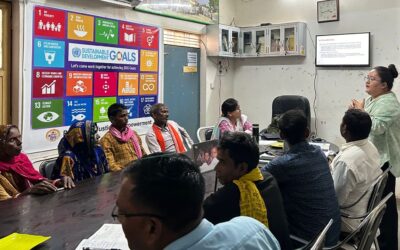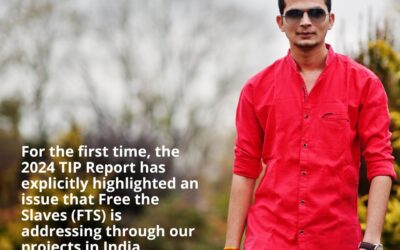Sara Sidner of CNN is continuing covering of Free the Slaves’ work in Uttar Pradesh, India. Just launched on Monday, CNN’s Freedom Project covers modern-day slavery all over the world. New stories are going online and broadcast every single day—a truly unprecedented scope of coverage. And Free the Slaves is honored and thrilled to be a part of it!
Yesterday Sara Sidner’s segment on debt bondage in India aired. CNN camera crews shot a brick kiln in Uttar Pradesh, India, where entire families are enslaved over bogus debts, forced to build bricks under threats of violence.
Watch Free the Slaves on CNN: Debt Bondage Slavery in India.
Today, the coverage continues with an exploration of the work being done to eradicate slavery in Uttar Pradesh. The segment begins with a raid. Law enforcement and Free the Slaves partners descended on a carpet loom known to house enslaved children. But when they arrived, it was virtually empty—the slaveholders had been tipped off, and had evacuated the loom.
Free the Slaves South Asia Director Supriya Awasthi (shown briefly in the video above), says “I freaked out, as it was a huge loom, but there were no kids there.” But the team of rescuers ran to the back of the building, where they found the children being shuffled away. Activists from Free the Slaves’ partner organization MSEMVS were able to rescue six bonded laborers—five children, and one disabled adult.
The footage above is hard to watch. The raid and rescue can be a terrifying moment for the victims. In some instances, victims have been rescued before, only to be re-enslaved. Without comprehensive, holistic programs that deal with the root causes of slavery, raids and rescues don’t lead to lasting freedom.
That’s why Free the Slaves created the Free a Village Build a Movement campaign, to empower entire communities to come out of the influence of their slaveholders. Through micro loans, villagers can become self sufficient. Schools help children become educated for the future. Villagers are empowered with knowledge of their rights. They learn to organize and demand justice.
Read how one village in India stood up to their slaveholders—and won.
CNN was able to capture some of this work. They interviewed formerly enslaved children, who spend their days in school, rather than toiling in looms or brick kilns. Sidner reports that some former slaves have filed an official complaint of sexual harassment agains their former slaveholder, describing it as “an act of courage” that “would never have been possible, if they hadn’t been told of their rights.”
Stay tuned for more coverage from the CNN Freedom Project! And read the accompanying CNN article by reporter Sara Sidner after the jump!
Fear accompanies road to freedom
Uttar Pradesh, India—Ten police officers barreled down the road, some on motorcycles, others in a jeep, their sirens left silent so as not to alert anyone. Their mission: to rescue workers from bonded labor, or debt slavery, in India.
But when they arrived at the carpet factory, it was empty except for a man inside.
It appeared that the police were too late.
As the man was questioned, officers outside discovered five children and a disabled adult who had been ushered out the back of the factory. Someone had tipped off the owner, police said.
The police took the group to the sub-divisional magistrate office, where the children reluctantly told their stories.
“We start work at 6 a.m., end at 9 p.m. at night,” the smallest said. In return for 15 hours of work, they received a food allowance of just two dollars per week. “My father is dead. So I am working.”
Some of the children didn’t even know how old they were. Their lives revolved around the factory owner’s demands. Despite being in police custody, they were afraid to say anything bad about their boss.
One boy cried for his mommy, as the group was being taken to a safe house. His mother didn’t know where he was, he said. A relative had taken him across state lines to work.
Sub-divisional Magistrate Ranvijay Singh called the problem intractable.
“The main problem is poverty,” he said. “Because of poverty their parents are forced to send their kids to work.”



